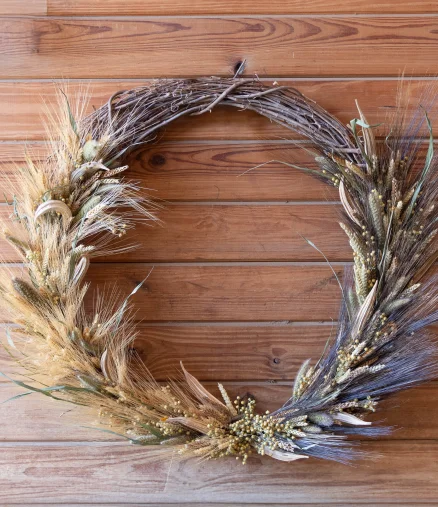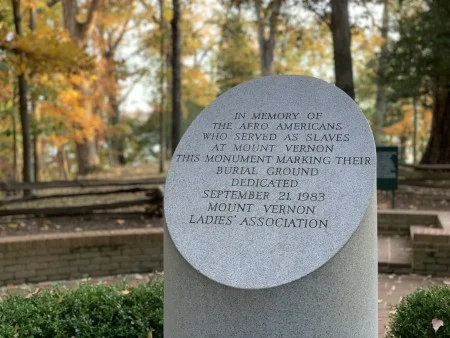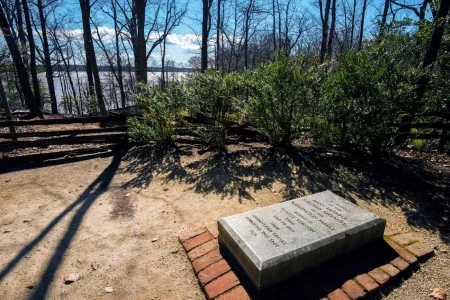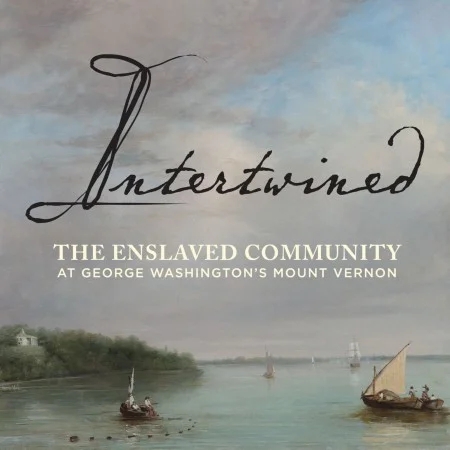Reflect on Past Slave Memorial Commemorations
To learn more about the spirit of this commemoration, you can watch last year’s ceremony.

In 2024, Mount Vernon commissioned local, mixed media artist, specializing in sustainable botanical materials, Valencia Wilson to create a sculptural wreath in honor of the event and its long and valued relationship with Black Women United for Action. Inspired by the strength and power of the enslaved men, women, and children at Mount Vernon, Wilson created the wreath to:
“[honor] the resilience of enslaved people by incorporating materials they would have harvested during their labor. The wreath features wheatgrass, millet, okra, and flax, symbolizing the crops central to their daily toil and sustenance. Each element speaks to their enduring legacy, with wheatgrass and millet representing sustenance, okra signifying cultural heritage, and flax embodying the strength and versatility they displayed in the face of adversity. This wreath serves as both a tribute and a reminder of the profound impact enslaved people had on shaping the land and its history.”
-Valencia Wilson, 2024
The Slave Memorial
The Slave Memorial at Mount Vernon marks the site where both free and enslaved people were buried in the 18th and 19th centuries, without permanent identifying markers. Among those thought to be buried at the site are William Lee and West Ford. Both Lee and Ford were free men at the time of their deaths.
The Memorial was designed by students attending the architectural school at Howard University. It was dedicated and opened to the public on September 21, 1983. A gray, truncated, granite column which represents “life unfinished” is the center of three concentric brick circles. The three steps leading up to the column are inscribed, respectively, “Faith,” “Hope” and “Love” – the virtues that sustained those living in bondage.
1929 Marker
The Slave Memorial stands adjacent to a monument erected on the site in 1929 by the Mount Vernon Ladies' Association to mark this sacred place. This marker is believed to be the earliest of its kind on a historic plantation.
It reads, “In memory of the many faithful colored servants of the Washington family buried at Mount Vernon from 1760 to 1860. Their unidentified graves surround this spot.” While the reference to “faithful colored servants” embodies a nostalgic view of slavery, the monument represented an early effort to acknowledge the lives of those who labored on the estate.
Slavery at Mount Vernon
Mount Vernon was the home of George Washington. It was also where hundreds of enslaved men, women, and children lived under Washington’s control. He depended on their labor to build and maintain his household and plantation. They, in turn, found ways to survive in a world that denied their freedom.
Learn MorePodcast: Intertwined
Intertwined: The Enslaved Community at George Washington’s Mount Vernon tells the story of the more than 577 people enslaved by George and Martha Washington at Mount Vernon.
Told through the biographies of Sambo Anderson, Davy Gray, William Lee, Kate, Ona Judge, Nancy Carter Quander, Edmund Parker, Caroline Branham, and the Washingtons, this eight-part podcast series explores the lives and labors of Mount Vernon’s enslaved community, and how we interpret slavery at the historic site today.

















